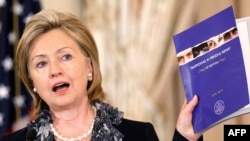The 2010 Trafficking in Persons report scrutinizing 177 countries keeps Armenia in the Tier 2 group of nations which Washington believes do not fully comply with “minimum standards for the elimination of trafficking” while making “significant efforts to do so.”
“The Armenian government increased its overall law enforcement efforts against human trafficking during the reporting period, however, it did not demonstrate efforts to prosecute cases linked to previous allegations of government officials’ complicity,” the State Department said.
According to official data, 11 individuals were tried and sentenced to between 3 and 13 years in prison on trafficking charges last year. None of the sentences was suspended. Only four persons received trafficking-related jail terms, ranging from 2 to 7.5 years, in 2008.
The Armenian police have portrayed the sharp increase as proof of their “serious work” aimed at eliminating cross-border transport and illegal exploitation of human beings from Armenia. Nearly 200 police officers reportedly participated in training courses aimed at deepening their understanding of the problem in 2009.
Official figures also show the number of persons officially identified as trafficking victims nearly doubling to 60 in the course of 2009. Twenty-two of them were referred to rehabilitation centers run by two non-governmental organizations for assistance. The vast majority of victims are Armenian women transported abroad and the United Arab Emirates in particular for sexual exploitation.
The U.S. State Department acknowledged these and other efforts when it removed Armenia from a Tier 2 “watch list” in June 2009. Its 2010 report notes that the authorities enacted last January legislation that increased the minimum penalty for convicted trafficking offenders to five years’ imprisonment. It describes as “sufficiently stringent” punishment for such crimes presently set by the Armenian Criminal Code.
U.S. officials complained in the past that Armenian law-enforcement bodies and courts are too lenient towards such individuals. The State Department stressed in 2008 that Yerevan should ensure that convicted traffickers “receive and serve adequate jail sentences.”
The 2010 report presented by Secretary of State Hillary Clinton in Washington says the authorities should do more to prosecute government officials suspect of aiding prostitution rings. “Although there were no new reports of government officials’ complicity in trafficking over the last year, the government demonstrated only modest progress in the reopened investigation of a well-documented 2006 corruption case,” it says.
The case relates to the 2006 escape from Yerevan’s Nubarashen prison of an Armenian-born Uzbek national convicted of trafficking. There is widespread suspicion that the woman, Anush Zakhariants, managed to flee Armenia with the help of senior law-enforcement officials. A senior Armenian official confirmed last year this was the main reason for the subsequent sacking of the prison chief.
The State Department also gave a mixed assessment of Armenian government efforts to identify and provide protection to trafficking victims. It regretted the authorities’ failure to spend funding allocated for victim assistance in 2009. Still, it noted a government decision to provide funding for facility rent for one trafficking shelter from February through December 2010.
The department report further makes clear that human trafficking in and from Armenia is not confined to forced prostitution. “Armenian men and women are subjected to forced labor in Russia, while Armenian women are subjected to forced labor in Turkey,” it says. “Armenian boys are subjected to conditions of forced labor and Armenian women and girls are subjected to forced prostitution within the country.”
“Women from Russia are subjected to conditions of forced labor in Armenia,” it adds without elaboration.




